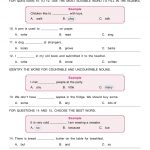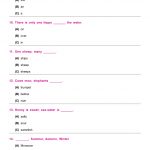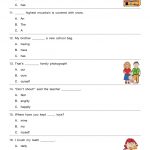Countable and Uncountable nouns
Nouns are used as uncountable nouns when they refer to a substance, material or phenomenon in general but they are used as countable nouns when they refer to one particular unit which is composed of that substance or to one occurrence of the phenomenon in question.
For more questions
A) Most nouns have singular and plural forms. They are countable nouns.
e.g. One letter, two letters
- There is a letter on the table for you. (singular)
- There are letters on the table for you. (plural)
B) Some nouns only have one form. They are uncountable nouns.
e.g. Money
- There is no money in my bank account.
- There is a lot of money in my bank account.
C) Many uncountable nouns refer to substances:
e.g. Chocolate, water, coffee, milk, sugar, salt, cheese, bread, rice, wood, glass, plastic, soap, toothpaste.
- Do you have any chocolate?
- The milk is sour – let’s make cheese.
- Rice is only edible when it has been cooked.
D) Many uncountable nouns refer to abstract ideas or emotions.
e.g. love, sadness, happiness, education, knowledge, and grammar.
- Money can’t buy love.
- We like to experience happiness.
- This education is priceless.
E) You can use a/an with singular countable nouns.
e.g. an umbrella, a wheel, a mistake.
- It’s raining so I need an umbrella.
- I made a mistake.
- This is a job for superman.
F) You can use plural countable nouns alone.
e.g. apples, bees, clouds.
- There are clouds in the sky today.
- There are bees making honey.
- We eat apples for breakfast.
G) You can’t use an article with an uncountable noun.
e.g. time, sand, electricity.
- We need electricity to use our heater.
- I lost track of time and we stayed up very late.
- The beaches in Brazil have very nice sand.
H) It is very common in English to use some / any with plural nouns and uncountable nouns (Refer to grammar notes on Some Any for more details).
e.g. They don’t listen to any advice.
- We don’t have any toys for the children.
- There are many lessons in life, this is just one more.
- It is important to have some knowledge of grammar.
I) There are a range of nouns that are uncountable in English but are countable in other languages.
These include: accommodation, advice, baggage, behaviour, bread, chaos, damage, furniture, information, luck, luggage, news, permission, progress, scenery, traffic, weather and work.
J) For comparison purposes, look at these sentences:
| Countable | Uncountable |
|---|---|
| I’m looking for a job. | I’m looking for work. |
| What a beautiful view! | What beautiful scenery! |
| It’s a nice day today. | It’s nice weather today. |
| We had a lot of bags and suitcases. | We had a lot of luggage. |
| These chairs are mine. | This furniture is mine. |
| It was a good suggestion. | It was good advice. |
Some and Any
We use SOME and ANY with plural nouns and uncountable nouns.
Some is generally used in positive sentences.
Any is generally used in negative sentences.
- I have some information for you about flights to Paris.
(Positive – Uncountable) - I don’t have any information for you about flights to Paris.
(Negative – Uncountable)
- We met some friends for drinks after work yesterday.
(Positive – Plural Countable) - I didn’t see any friends there on Thursday.
(Negative – Plural Countable)
- I think he will have some time to speak to you today.
(Positive – Uncountable) - I don’t think he will have any time to speak to you today.
(Negative – Uncountable)
You can also use SOME and ANY in a sentence without a noun if the meaning of the sentence is clear.
- I didn’t eat any salad but Peter ate some. (salad)
- Sean took lots of photos of the mountains but Emma didn’t take any. (photos)
Examples of countable nouns
In English most of nouns belong to the category of countable nouns. These nouns form plural forms by adding the ending -s or -es.







